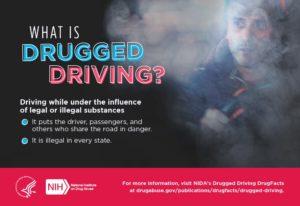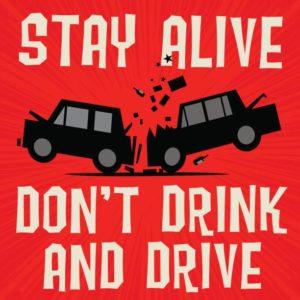Help Keep Drunk Drivers Off Our Roads
According to the National Highway Traffic Safety Administration (NHTSA), someone dies in an alcohol-related car collision in the United States every 52 minutes. They account for 1/3 of all traffic crashes and are all preventable. Since 1982, more Americans have been arrested for drunk driving than any other criminal offense. These disturbing facts are not someone else’s problem. Drunk drivers share the road with you and your family. They put all of our lives in danger.
Myths about Drinking and Driving
Despite the fact that some people feel more outgoing when they’ve had a couple drinks, alcohol is actually a depressant. It affects the central nervous system, impairing vision, coordination, judgment and reaction time. Because judgment is affected, the drinker usually thinks it’s okay to drive. But they are not actually capable of making that decision.
Here are three common myths about drinking and driving:
1. MYTH: You can sober up with black coffee, a cold shower, fresh air or exercise.
REALITY: Nothing sobers up a drinker except time. While a number of factors affect how quickly someone becomes impaired (i.e. their weight and how much food is in their stomach), the body needs about one hour to process each ounce of liquor. Depending upon a person’s height and weight, a person who has had five drinks in two hours burns off only about two ounces of the alcohol, and will need at least three more hours of non-drinking time to become sober.
2. MYTH: Drinking beer or wine doesn’t make you drunk like hard liquor does.
REALITY: An ounce of any type of alcohol has the same power to affect the drinker. A 12 oz. beer, a 5 oz. glass of wine and a 1 oz. shot of hard liquor all contain about the same amount of alcohol. When considering how much you are drinking, remember that some mixed drinks contain more than one shot of alcohol.
3. MYTH: You can tell if someone is sober enough to drive just by looking at them.
REALITY: Some people can hardly stand up or string together a coherent sentence when they’ve been drinking while other people are equally intoxicated but never stumble or slur their words. You can’t judge whether they should be driving based on how they are acting or their physical appearance.
LOWERING BLOOD ALCOHOL CONTENT (BAC) LEVELS ON THE LEGAL LIMIT
Increasingly, states are changing the blood alcohol content (BAC) level at which one is considered legally drunk from .10% to .08%, even though any drivers that have a BAC higher than .00% are impaired. In Michigan, you are presumed legally drunk at .08%.
ZERO TOLERANCE FOR MINORS
Zero tolerance laws make it illegal for persons under the age of 21 to drive with any measurable amount of alcohol in their blood. Minors who violate this law usually lose all driving privileges. Because of the variation in alcohol testing instruments, some states use .00, .01, .02 BAC to define zero tolerance.
DRUGGED DRIVERS
In 2020, the NHTSA reported that 56% of drivers involved in serious injury and fatal crashes tested positive for at least one drug. Alcohol is not the only substance that can impair drivers. Many drugs, including over-the-counter and prescription medications, may cause side effects that make it unsafe to drive. Even if the physical effects of an allergy medicine or sleeping pill have worn off, your reasoning, coordination or vision may still be impaired. Take seriously the warning labels on your medication, and ask your doctor or pharmacist about possible side effects to drugs you are taking.
prescription medications, may cause side effects that make it unsafe to drive. Even if the physical effects of an allergy medicine or sleeping pill have worn off, your reasoning, coordination or vision may still be impaired. Take seriously the warning labels on your medication, and ask your doctor or pharmacist about possible side effects to drugs you are taking.
Antihistamines are found in many nonprescription cold and cough medications, decongestants, hay fever and allergy remedies. They may cause drowsiness, which can slow your reaction time on the road.
Tranquilizers may reduce tension and anxiety, but they also may reduce your hand-eye coordination as well as your judgment. You may think you are perfectly capable of driving when you are not! Sleeping pills and barbiturates can produce identical effects, and can last as many as 14 hours.
Stimulants make you more alert temporarily, but soon may cause dizziness, loss of concentration, and problems with vision. Amphetamines, which can relieve depression and curb one’s appetite, can give drivers false confidence in their abilities. Cocaine could cause a lack of concentration that could put you in a car crash.
Pain Relievers may have codeine or stronger ingredients that may seriously affect your ability to remain alert behind the wheel. Using drugs in combination with alcohol not only will make you dangerous on the road, it can even kill you if you’re staying at home.
Marijuana is medically and recreationally legal in many states, including Michigan. However, use can impair judgement, affect motor coordination and reaction time.
Unlike alcohol that can be measured by breath tests to find the BAC level of someone who has been drinking and driving, there is no set standard of measuring drug levels on a scene. Blood tests have to be done to find out what kind and how much drug(s) are in someone’s system, but the tester would have to have an idea of what drugs to test for.



